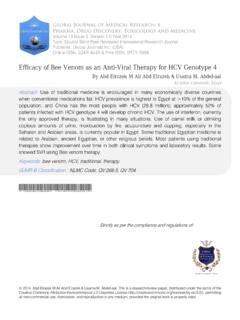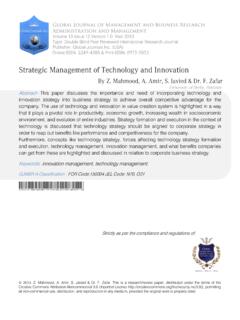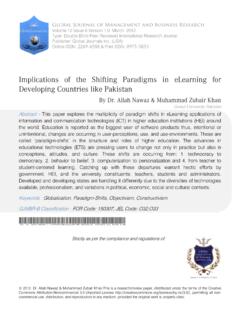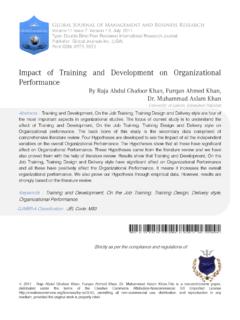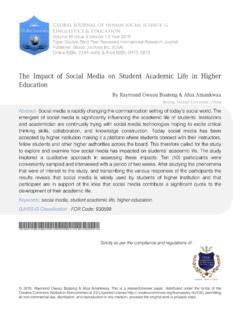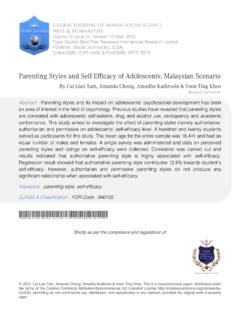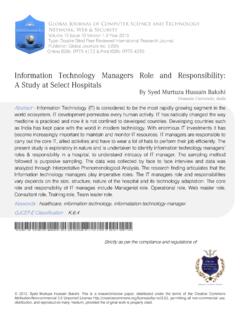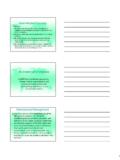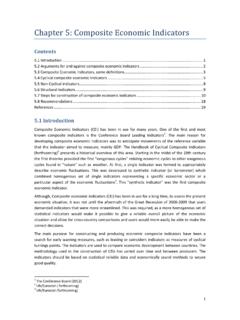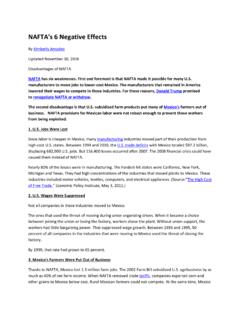Transcription of Jeffrey Sachs, (2005). The End of Poverty: Economic ...
1 Global Journal of Management and Business Research: B Economics and Commerce Volume 14 Issue 6 Version Year 2014 Type: Double Blind Peer Reviewed International Research Journal Publisher: Global Journals Inc. (USA) Online ISSN: 2249-4588 & Print ISSN: 0975-5853 Jeffrey Sachs, (2005). The End of Poverty: Economic Possibilities for our Time. New York: The Penguin Press. (Book Summary and Book Review) By Dr. Kazi Abdur Rouf Noble International University, USA JeffreySachs,2005 TheEndofPovertyEconomicPossibilitiesforo urTimeNewYorkThePenguinPressBookSummarya ndBookReview Strictly as per the compliance and regulations of: 2014. Dr. Kazi Abdur Rouf. This is a research/review paper, distributed under the terms of the Creative Commons Attribution-Noncommercial Unported License ), permitting all non-commercial use, distribution, and reproduction in any medium, provided the original work is properly cited.
2 Abstract-This paper is a book review of the book The End of Poverty: Economic possibilities for our time written by Nobel Laureate Jeffrey Sacks (2005), an American renounced economist and director of the Earth Institute, Columbia University. In the book, Sachs talks about global poverty issues and their miseries in poor countries. Moreover, he provides statistics with examples of the many problems related to Economic , educational, population, cultural, health and environmental issues. He narrates in detail the poverty of Malawi, Bangladesh,Kenya, India and Bolivia. The book compares and contrasts the Economic histories of China, Russia and India. The book also narrates the current Chinese and Indian Economic booms in the global context. The book contains Economic histories of many countries; it has many suggestions for Economic policy reforms and cooperation among rich and poor countries.
3 It contains suggestions for improving donor funding plans, and strategies for ending poverty in poor countries. Keywords or phrases: clinical economics, corruption, donors funding, international funding policies, Economic development, Economic policy reforms, information technology (it), millennium development goals (mgds), poverty, poverty Classification: JEL Code:P46, I39 Jeffrey Sachs, (2005). The End of Poverty: Economic Possibilities for our Time. New York: The Penguin Press. (Book Summary and Book Review) Dr. Kazi Abdur Rouf Abstract- This paper is a book review of the book The End of Poverty: Economic possibilities for our time written by Nobel Laureate Jeffrey Sacks (2005), an American renounced economist and director of the Earth Institute, Columbia University.
4 In the book, Sachs talks about global poverty issues and their miseries in poor countries. Moreover, he provides statistics with examples of the many problems related to Economic , educational, population, cultural, health and environmental issues. He narrates in detail the poverty of Malawi, Bangladesh, Kenya, India and Bolivia. The book compares and contrasts the Economic histories of China, Russia and India. The book also narrates the current Chinese and Indian Economic booms in the global context. The book contains Economic histories of many countries; it has many suggestions for Economic policy reforms and cooperation among rich and poor countries. It contains suggestions for improving donor funding plans, and strategies for ending poverty in poor countries.
5 Jeffrey Sachs describes World Bank and International Monetary Fund (IMF) activities and their wrong, stereotypical funding policies and strategies for different countries, particularly those in Africa. He identifies information technology (IT) flow, different technological innovations, technological change and its development (invention of the steam engine, use of coal, invention of the rail engine and railway, electrification of industry) and their contributions to world development. Poor countries are using less IT and technology; however. as a result, they get fewer benefits from them than rich countries. Hence there are needs for use of more IT in poor countries. The book suggests simultaneous trade investments in and aid to poor countries for their socio- Economic development, in addition to technology and energy support to them.
6 Moreover, at the end of the book, Jeffrey Sachs provides nine tips / actions / steps for ending poverty around the world: 1) adopt a plan of action; 2) raise the voice of the poor; 3) redeem the role of the United States in the World; 4) rescue the IMF and the World Bank (they have been misused as creditors; 5) run agencies, rather than international institutions, that represent all of the 182 member governments; 6) strengthen the United Nations; 7) harness global science; 8) promote sustainable development; 9) make a personal commitment. Author: Visiting Professor, Chittagong University, Bangladesh. Visiting Scholar, Faculty of Environmental Studies, York University, Canada. Associate Professor, Noble International University, USA.
7 However, to fulfill Millennium Development Goals (MDGs), it is urgently necessary that rich countries donate the Gross National per Capita (GNP) to poor countries that they committed to at the 1949 and other UN Conventions. Poverty exists in both poor and rich countries; therefore, it is necessary to challenge globalization with acts for pro-globalization (good things) and initiate green social Economic projects and services in rich as well as poor countries for the sake of ending their poverty. Keywords or phrases: clinical economics; corruption; donors funding; international funding policies; Economic development; Economic policy reforms; information technology (it); millennium development goals (mgds); poverty; poverty trap.
8 I. Introduction effrey Sachs (2005), the Nobel Laureate and Director of the Earth Institute, Columbia University, in his book The End of Poverty: Economic possibilities for our time provides global poverty statistics and describes many countries poverty situations with examples. The book narrates the role of international institutions like the World Bank and the International Monetary Fund (IMF) in increasing poverty in developing countries. Jeffrey Sachs raises many issues of social, Economic , and cultural nature, such as public health, HIV Aids, child mortality, maternal mortality, population problems, malaria, polio etc. in the book. He articulates environmental problems like environmental pollution and climate change, and their devastations that destroy our Mother Earth in different countries and exacerbate global poverty, particularly in the developing countries.
9 The book describes how the poverty trap works globally at the expense of the human face. It narrates the ups and downs of the Economic development histories of different countries like India, China, Russia, and Japan. Moreover, the book compares and contrasts the Economic histories of China, Russia and India. The book mainly focuses on global poverty and its miseries in the poor countries. Jeffrey Sachs provides many suggestions in the book about how to end poverty in the poor countries. He narrates with examples how different countries have started their Economic J 2014 Global Journals Inc. (US)67 Global Journal of Management and Business Research Volume XIV Issue VI Version IYear2014 () B Jeffrey Sachs, (2005).
10 The End of Poverty: Economic Possibilities for Our Time. New York: The Penguin Press. (Book Summary and Book Review)development processes. The book tells about technological change, the flow of technological innovations and their development (invention of the steam engine, use of coal, invention of the rail engine and railway, electrification of industry), IT information flow and their contributions in society. The book also argues the pros and cons of science and technology and their contributions to Economic progress and Economic decline throughout the world. Moreover, the book touches upon the contribution of computers to socio- Economic development in society; however, there are problems that exist in using computers and IT in the developing countries.



